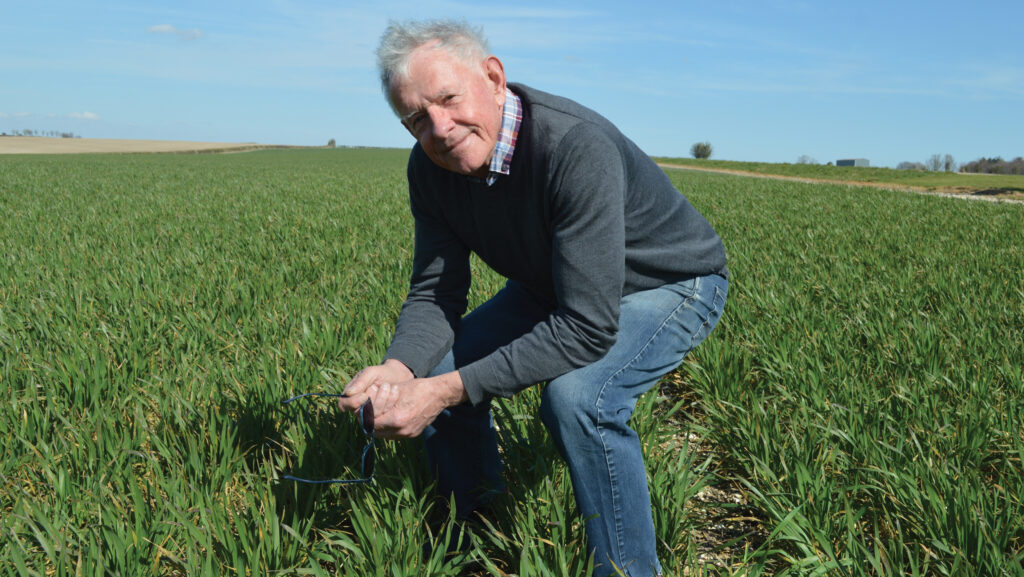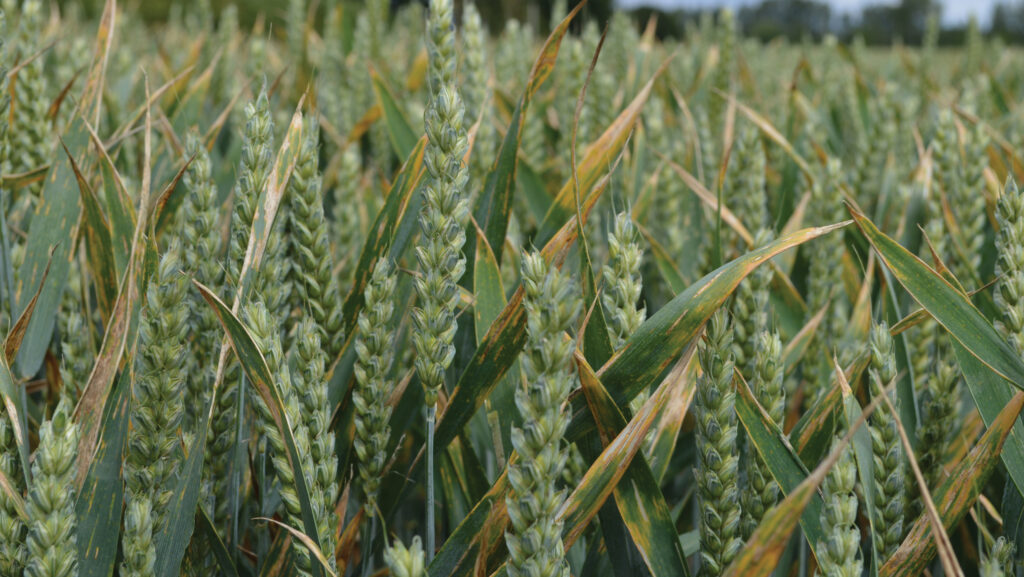Septoria-specific spray is key for Dorset wheat grower
 Bob Rowe in the crop of wheat blend of Redwald and Bamford © David Jones
Bob Rowe in the crop of wheat blend of Redwald and Bamford © David Jones Bob Rowe is very pleased with the performance of a new SDHI fungicide he used across all his 700ha of winter wheat in 2024, as it largely kept septoria out of his Dorset crops in a high-disease year.
He used the latest SDHI Adepidyn at the T2 flag leaf stage in May and in a low-yield year nationally achieved wheat yields of more than 10t/ha, with his best variety Redwald managing 11.3t/ha, in a high-risk area for the wet weather-loving disease.
See also: Suffolk wheat grower goes for broad-spectrum disease control at T1
The fungicide, under the brand name Miravis Plus, was only cleared for use in April 2024, but Bob was keen to use it across all his wheat due to its top-performance against septoria, which is his main disease worry.
“We will definitely be using Miravis this year at T2 if the yield potential is there. We were very pleased with it last year as it did a great job, but it needs to be competitively priced,” Bob tells Farmers Weekly.
Miravis Plus will compete with another newly launched SDHI fungicide, Vimoy (Iblon), and more established mixed products Univoq and Revystar this spring.
But Miravis Plus’s superior septoria control may see it priced higher, at £60/ha-plus in conjunction with its recommended partner azole.
Bob farms 1,400ha of owned and contract farmed land from Manor Farm, Gussage St Michael, on the light chalky soils of Cranborne Chase, some six miles north-east of Blandford Forum, growing a variety of combinable crops.

Some septoria was present in the lower leaves of the crop © David Jones
Last season
With rainfall levels gradually increasing in this part of east Dorset and up to 1,220mm in 2024, he points out the farm always sees a good yield response from sprays aimed at controlling septoria.
His fungicide spend last year for his five-spray programme was close to £160/ha, but he says that amount needs to be spent to achieve his five-year average winter wheat yield of 10.5-11t/ha.
Last season, he managed to stay on top of the high disease risk with septoria kept to the lower leaves, while he rarely sees problems with yellow and brown rust.
He started his fungicide programme in 2024 with the biological Iodus (laminarin) at T0 across all his five varieties of Champion, Oxford, Redwald, Extase and Palladium, some of which were in mixture such as Champion together with Oxford.
At the T1 timing in late April he tried the newly available Vimoy with its advised azole partner prothioconazole which he was pleased with as it kept septoria under control.
But in such a high disease year he was keen to protect leaf two so applied a half rate of prothioconazole at T1/1.5.
He was impressed that in his own farm trials a Vimoy-prothioconazole spray at T1 gave a 0.85t/ha yield response compared with his old T1 farm standard, Ascra.
Through to the flag leaf T2 spray, he used Miravis Plus at the recommended rate of 1.5 litres/ha and allied this with a half rate of its recommended partner prothioconazole, and in addition a half rate of the relatively new azole mefentrifluconazole (Myresa).
This brought together the best SDHI and best azole for septoria control.
The result was good control of septoria on the upper leaves of his wheat crops. His T3 ear spray was a relatively inexpensive azole-strobilurin prothioconazole/azoxystrobin (Amistar) mix.

© David Jones
Wheat blends
For this season, there is a bigger area of wheat blends with 75% of this year’s 600ha of wheat down to a Bamford/Redwald mix, with most of the rest in a Champion/Beowulf blend with 60ha of straight Bamford.
The move to more blends is for better grain quality and disease resistance.
Bob’s T0 will again be Iodus with multisite floret added. T1s will be Vimoy-prothioconazole for his first wheat, and Univoq on other wheats.
Vimoy has a limitation on the use of its active over two years which makes it unlikely to be used on a second cereal.
For the T2 flag-leaf spray, Miravis Plus is definitely in the plan if his wheat crops look to have good yield potential with prothioconazole added or possibly Revypro if deemed necessary.
His 60ha of poorer-looking second wheat may get a less expensive programme of Ascra at T1 and Univoq at T2 if it does not look to have a high yield potential.
His T3 is again likely to be prothioconazole + azoxystrobin, making a relatively inexpensive head spray costing £11/ha.
Adepidyn
Syngenta’s Adepidyn, chemical name pydiflumetofen, is sold under the brand name Miravis Plus and was approved for use in early April 2024.
It was used as a T2 spray on a limited number of winter wheat crops in that year.
It is available in a twin pack with the azole prothioconazole under the brand name Miravis Plus + Era. It will be available for the whole of the 2025 season.
Miravis Plus + Era – contains 62.5g/litre of SDHI Adepidyn/pydiflumetofen, in a twin pack with prothioconazole (Era).
The recommended rate on winter wheat for Miravis Plus is 1.5-2 litres/ha with Era at 0.5-0.65 litres/ha, with Syngenta seeing it largely being used at 1.5 litres/ha of Miravis Plus and 0.5/litres of Era.
Only one application of the Adepidyn-containing product is allowed each season.
Syngenta says the mixed SDHI-azole product has very good control of septoria, gives good control of brown rust and moderate control of yellow rust.
Miravis Plus + Era is likely to be aimed at the T2 timing in winter wheat due to its good control of septoria and so its protection of the flag leaf, while it will also suppress fusarium, which could be useful when considering T3 sprays.
In high-risk rust situations, a strobilurin such as Syngenta’s Amistar (azoxystrobin) or a fast-acting rust active azole such as tebuconazole can be added.
Independent trials
Adepidyn has been shown in independent trials to be the best fungicide for controlling septoria in wheat.
The SDHI shows moderate control of brown rust, while yellow rust control is not on the product’s label.
Mixing with the azole prothioconazole (Era), improves control levels of all three main wheat diseases – septoria, yellow rust and brown rust.
The control of yellow rust comes from the prothioconazole.
The ADHB says single-spray average yield responses in septoria trials (over the last three years) indicated that Miravis Plus increased yields by 0.4t/ha compared with Peqtiga, the next most effective solo active, when compared at a full-label dose.
On brown rust, Miravis Plus shows useful activity when applied on its own, and it will add to the efficacy of partnered products, says the AHDB.
It is not as active as other SDHIs, such as Vimoy, Elatus Plus or Imtrex on brown rust.
In addition, Miravis Plus has excellent activity against fusarium when compared with the azole standard for the disease prothioconazole, it adds.
Key wheat fungicide actives
- Ascra – SDHIs bixafen and fluopyram plus azole prothioconazole
- Elatus Era – SDHI benzovindiflupyr (Solatenol) plus azole prothioconazole
- Elatus Plus – SDHI benzovindiflupyr (Solatenol)
- Imtrex – SDHI fluxapyroxad (Xemium)
- Miravis Plus – SDHI pydiflumetofen (Adepidyn), in a twin pack with azole prothioconazole (Era)
- Myresa – Azole mefentrifluconazole (Revysol)
- Peqtiga – Picolinamide fenpicoxamid (Inatreq)
- Plaxium – SDHIs isoflucypram (Iblon) and fluopyram, plus azole prothioconazole
- Revypro – Azoles mefentrifluconazole and prothioconazole
- Revystar – SDHI fluxapyroxad (Xemium) plus azole mefentrifluconazole (Revysol)
- Univoq – Picolinamide fenpicoxamid (Inatreq) plus azole prothioconazole
- Vimoy – SDHI isoflucypram (Iblon), in a twin pack with azole prothioconazole (Proline)

